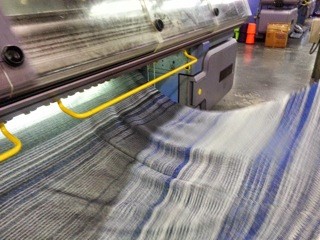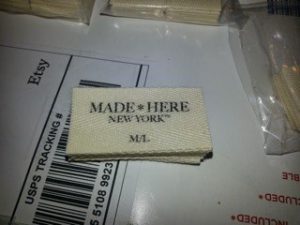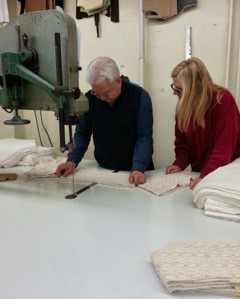
Fashion designer Karyn Villante created MADE*HERE NEW YORK, a line of sweaters and blankets that is designed to give "consumers an outlet to shop with a conscience." As its name states, the company manufacturers its products in New York, using recycled yarns or natural fibers such as cotton that is grown in the United States.
We chatted with Villante about why she launched MADE*HERE NEW YORK and where she sees the company going.
1. I know you have a background in fashion design, particularly in designing sweaters. Can you start by telling us a little bit about it?

I went to the Fashion Institute of Technology, and graduated with a degree in Fashion Design, and a bachelor's degree in Textile Production Management. After graduation, I worked as a designer for an import company for a few years. I wanted to work for a domestic manufacturer and see the knitdowns come right off of the machine. I then got a job at Pandora, a great company that unfortunately is no more. Pandora was located in Manchester, N.H., and the knitting mill was in a beautiful old building. There used to be many knitting mills located in the northeast, but no more. When Pandora went out of business, I got a job at United States Sweaters, where I was the designer and merchandiser. We did many private label programs for Macy’s, Lord and Taylor, Bloomingdales, etc. We also launched a junior sweater line, Boca Blue. All of our sweaters were made in New York. It was great to go the knitting mills, see the knitdowns, change yarns, tweak a design — right there and then.
2. What inspired you to start manufacturing your own line? Why did you decide to manufacture in NY?
My oldest daughter inspired me. She had worn a sweater that she had taken out of my closet — one that was designed on a machine that was undoubtedly in a landfill somewhere — and she wore it often, and received many compliments. I had been out of the business for a while, leaving my career to be there for my children as they grew up. She said: “Mom, you should make sweaters again, what are you doing to do when H goes away to college?” Everyone I knew had either gone out of business or switched to imports. Or so I thought. With persistence and lots of phone calls, and pounding the pavement, I was able to find some knitting mills willing to work with me and make small quantities. The knitting mills are in the New York metropolitan area are easy for me to get to. I really love working in the mills, seeing the knitdowns, the yarn, the stitches.
3. What obstacles did you run into when you were getting started? How did you overcome them?
There are many obstacles. Quantity is one obstacle. I had to start with small quantities because money is an issue. The knitting mills that are still in business are still in business because they might be knitting large volume orders, and a small production order can interfere with their flow. A small order can easily get lost in the midst of a mill who is trying to finish a 500 dozen order for someone else. Luckily, I was able to find mills that would produce small orders. My background as a designer in the domestic business did open some doors. I was flexible with the sizes I made, as well. I limited the amount of colors also. Start small, but start. Other obstacles are the minutiae of dealing with your own business like shipping yarn from one place to another — I didn’t know that I needed to know what a lift gate was on a truck, and that I did indeed need one when I shipped yarn to a factory.
4. Why are you so passionate about Made in America?

I am passionate about Made in America for so many reasons. For one thing, the industrial revolution started here, and made this country strong. If you buy American made products you are saving American jobs, then the proceeds stay in the U.S. The United States has regulations on manufacturing that third world countries do not. Importing clothing from overseas costs a tremendous amount — think of the petroleum used by shipping across the world. American companies abide by many rules that protect the workers. Many third world countries, where “fast fashion” is made, do not. The factory collapse in Bangladesh is one very sad example. When Ralph Lauren made the Olympic uniforms a couple of years ago in China, I was disgusted. Here’s a company with all the resources to get some United States factories going. What a shame, and then I thought.: "Let me try and see if I can find some knitting mills still around, maybe I could make some sweaters." The idea grew and grew.
5. What advice would you give to people looking to buy more American-made products, especially clothing and accessories?
Look at the label!! There are clothing companies out there that still manufacture in USA. Go to the Internet- — there’s a lot of information at your fingertips — USA Lovelist, MadeinUSAForever are two sites that list American made products.
6. What advice would you give to those folks who want to start manufacturing in the U.S., but might not know how?
Start doing research now. Go to trade shows for your market. Network, talk to everyone and anyone who will listen. (I approached Gov. Cuomo when I saw him in a restaurant — I gave the best elevator pitch ever! From that quick pitch, I was able to meet with the Empire State Development Council. The EDC directed me to Wix.com who helped me develop my website.) Someone might know someone who can help you. Take notes, stay organized. Get your tasks planned. Take small steps but each day try to move forward.
7. Where would you like to see the company go in the next few years?
I would like MADE*HERE NEW YORK™ to become a brand that people will seek out for quality sweaters, blankets and other knit accessories that are Made in USA. Our site will have much more product and a blog, with articles and content about buying Made in USA, and also about reducing, re-using and recycling. We use eco-friendly sustainable yarn. In the next year, MADE*HERE NEW YORK™ will participate in some pop-up shops to build exposure for the brand.
